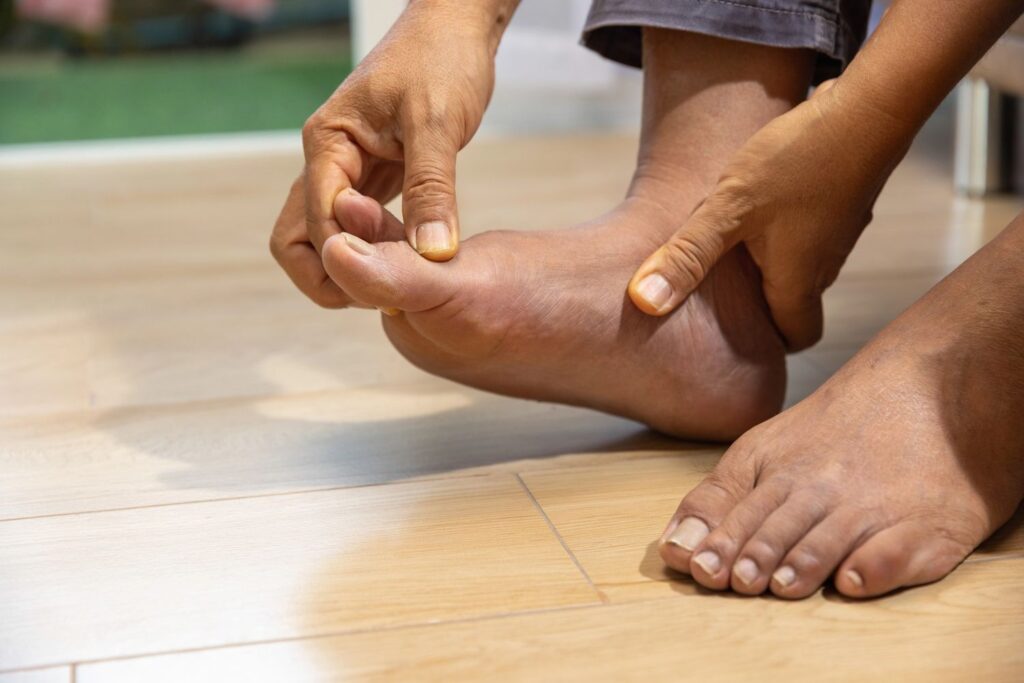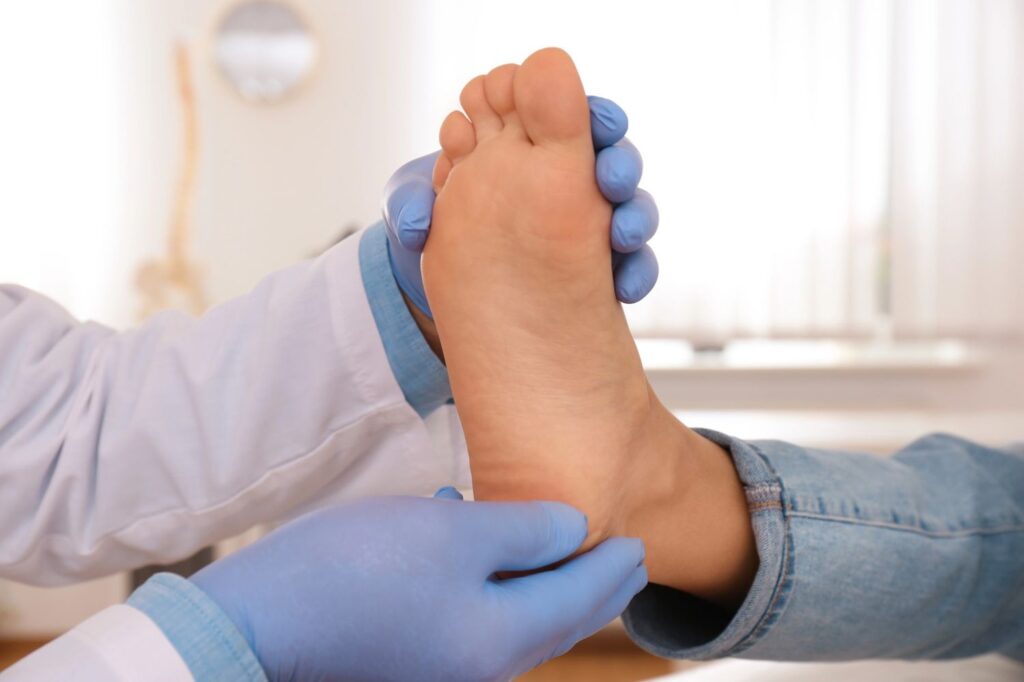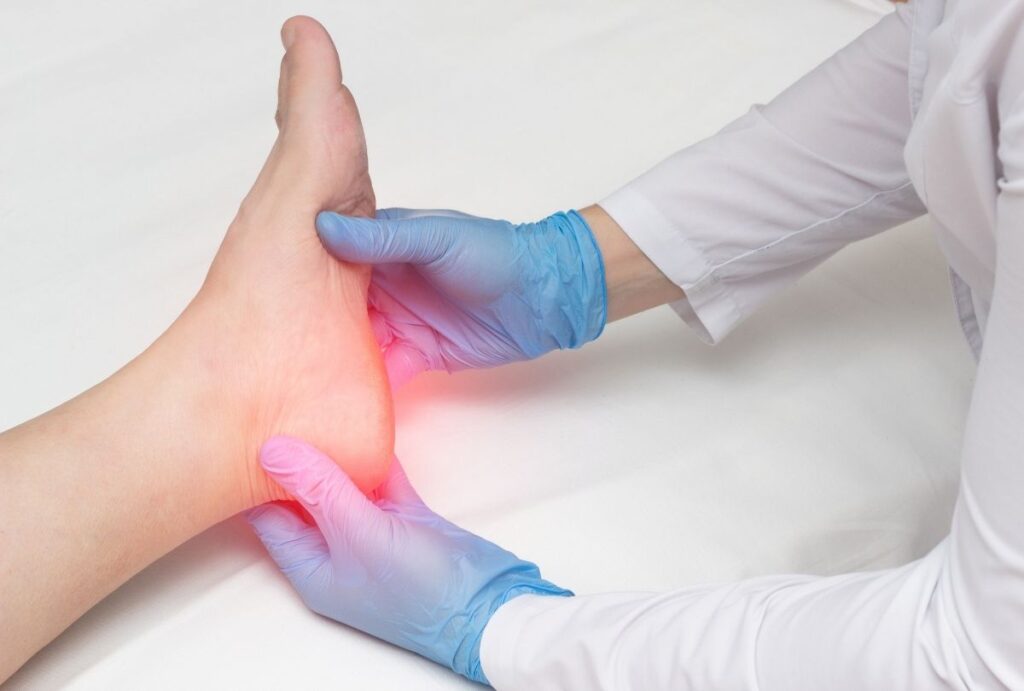Ingrown toenails are a common and painful foot condition. While some people try at-home remedies, others wonder if it’s worth seeing a specialist. So let’s answer the question: can a podiatrist fix an ingrown toenail? The short answer is yes—podiatrists are trained medical professionals who specialize in diagnosing and treating foot and ankle problems, including ingrown toenails. In this blog post, we’ll explain how podiatrists treat ingrown toenails, when to seek professional care, and what to expect during and after treatment.
What Is an Ingrown Toenail?
An ingrown toenail happens when the corner or side of the toenail grows into the soft skin surrounding it, causing pain, redness, swelling, and sometimes infection. It most commonly affects the big toe, although any toenail can be affected.
The causes of ingrown toenails include:
- Trimming nails too short or rounding the edges
- Wearing tight shoes or high heels that crowd the toes
- Injuring the toe (e.g., stubbing it or dropping something on it)
- Genetics (some people naturally have curved or thick toenails)
- Poor foot hygiene or repetitive toe trauma from running or sports
In the early stages, the nail may only cause mild discomfort. As it progresses, it can lead to infection, discharge, and significant pain that interferes with walking. Understanding the condition is the first step toward choosing the appropriate treatment path.
Signs You May Need Professional Help
While a mild ingrown toenail might improve with proper self-care, many cases need the attention of a podiatrist. Here are specific signs that it’s time to seek professional treatment:
- Persistent or worsening pain despite home treatment
- Redness and swelling that continues to spread
- Presence of pus or yellowish drainage, which may indicate infection
- A warm or tender feeling around the nail bed
- Thickened skin at the nail border or excessive granulation tissue (skin growth)
- Recurrence even after previous treatments
Additionally, individuals with medical conditions like diabetes, poor circulation, or neuropathy should avoid trying to treat ingrown toenails themselves. These conditions reduce healing ability and increase the risk of serious infection. For them, seeing a podiatrist early can help prevent complications such as foot ulcers or cellulitis.
How Does a Podiatrist Fix an Ingrown Toenail?
Podiatrists use different methods depending on the severity of the ingrown toenail and whether it has become infected or chronic. Each treatment is tailored to the patient’s condition, health status, and history of toenail problems.
1. Conservative Nail Trimming
For cases caught early, the podiatrist may trim or file the nail edge to reduce pressure against the skin. This conservative method can help realign nail growth over time. The procedure is done using sterile tools and often includes cleaning the affected area to reduce inflammation.
Podiatrists may also remove any debris under the nail and inspect for early signs of infection. Afterward, they usually advise patients on proper nail-cutting techniques—specifically, cutting straight across and avoiding deep corners. They may also assess footwear to ensure it’s not contributing to the issue.
This approach is painless and requires no downtime, making it ideal for patients who seek early intervention.
➡️ Best for: Mild ingrown toenails with no sign of infection or tissue overgrowth.
2. Nail Lifting (Partial Nail Elevation)
If the toenail is slightly embedded but not infected, podiatrists may lift the nail edge to prevent it from digging further into the skin. They may place a small wedge of cotton, gauze, or dental floss under the nail to gently separate it from the skin and encourage outward growth.
This treatment typically involves antiseptic solutions to keep the area clean and reduce inflammation. The wedge is replaced daily, and the toe is monitored for signs of improvement.
Although nail lifting can be done at home for very mild cases, podiatrists ensure it’s done hygienically and offer tips for care during the healing process. This method is simple but effective for correcting nail direction before it progresses.
➡️ Best for: Early or moderate cases without infection or granulation tissue.
3. Partial Nail Avulsion (Minor Surgery)
When the toenail becomes embedded deeply or infected, partial nail avulsion becomes the go-to solution. This minor in-office surgical procedure involves removing the portion of the nail that is growing into the skin.
Here’s what happens:
- The toe is numbed with a local anesthetic.
- A section (usually one-third) of the nail is carefully removed.
- If needed, pus or inflamed tissue is drained.
- An antiseptic is applied, and the toe is bandaged.
This process provides immediate relief and allows the inflamed tissue to heal. Recovery is usually quick, and patients are advised to soak the toe in warm salt water, apply ointment, and wear roomy footwear for a few days.
➡️ Best for: Moderate to severe cases or when signs of infection are present.
⏱️ Recovery Time: Most patients return to normal activity within 1–3 days, though complete healing may take up to two weeks.
4. Matrixectomy (Permanent Nail Removal)
For chronic or recurring ingrown toenails, podiatrists may recommend a matrixectomy. After removing part of the nail, the nail matrix (the root that produces nail growth) is treated with a chemical agent like phenol or a laser. This stops the regrowth of the problematic portion of the nail, preventing future issues.
This method can significantly reduce recurrence rates and is often recommended for patients who have had multiple ingrown toenails on the same toe.
➡️ Best for: Repeat offenders—patients with frequent ingrown toenails or thick, curved nails that continue to cause problems.
📝 Note: Most matrixectomies are partial, preserving the majority of the toenail’s appearance while eliminating the painful edge.
What to Expect During and After Treatment
Visiting a podiatrist can feel intimidating, especially if it’s your first time. However, ingrown toenail procedures are generally fast and minimally invasive. Here’s what typically happens:
- The podiatrist will examine your toe and take a brief medical history.
- If minor treatment is needed, it may be done immediately.
- For procedures like nail avulsion, the area will be numbed.
- The procedure itself typically lasts 15–30 minutes.
- Aftercare instructions are given, including cleaning tips and when to change bandages.
- A follow-up appointment may be scheduled to monitor healing.
After treatment, you might experience slight soreness or redness, but significant pain usually resolves quickly. It’s important to avoid pressure on the toe, wear loose-fitting shoes, and keep the foot clean and dry. If antibiotics are prescribed, be sure to complete the full course.
Risks of Not Treating an Ingrown Toenail Properly
Ignoring an ingrown toenail or managing it incorrectly can lead to:
- Chronic pain and recurring inflammation
- Development of abscesses or open sores
- Bacterial infection spreading to deeper tissues or bone
- Nail deformities or permanent damage
- In diabetics, increased risk of foot ulcers and amputation
For people with compromised immune systems, these risks are even more serious. Prompt and professional care can prevent these outcomes and restore normal function to the affected toe.
Can Ingrown Toenails Come Back?
Unfortunately, yes. Even after treatment, some people experience recurrence due to genetic nail shape, underlying foot structure, or lifestyle habits. Wearing tight shoes, improperly cutting toenails, or engaging in activities that put repetitive pressure on the toes can cause the condition to return.
The good news is that podiatrists can offer long-term solutions, including permanent removal of part of the nail root (matrixectomy), orthotic advice, or guidance on shoes and hygiene. With the right care and attention, the frequency and severity of recurrence can be reduced significantly.
How to Prevent Ingrown Toenails
Preventing ingrown toenails is often easier than treating them repeatedly. Here are preventive steps podiatrists commonly recommend:
- Cut nails straight across—never rounded or too short
- Avoid cutting down the sides of the nail
- Wear shoes with enough room in the toe box
- Keep your feet clean and dry
- Replace socks daily and avoid sweaty shoes
- Avoid picking or tearing your nails
For athletes or those who spend long hours on their feet, custom orthotics or padding may also be helpful. Regular visits to a podiatrist can help monitor nail health and catch early warning signs before they turn painful.
Vital Podiatry Foot and Ankle Specialist Serving the Schroeder Oaks Village Community and Beyond in Houston
Vital Podiatry Foot and Ankle Specialist is dedicated to serving the diverse needs of the local community of Houston, including individuals residing in neighborhoods like Schroeder Oaks Village. With its convenient location near landmarks such as the Cypress Christian School and major intersections like Jones Road & Cypress North Houston Rd (coordinates: 29.950646307764426, -95.58487044067478), we offer podiatrist ingrown toenail services.
Get Podiatrist ingrown toenail Services at Schroeder Oaks Village Now
CALL US NOW!
(281) 937-4546
Navigate from Schroeder Oaks Village to Vital Podiatry Foot and Ankle Specialist Now
Final Thoughts
Can a podiatrist fix an ingrown toenail? Yes—and in many cases, they provide the most effective, long-term solution. From conservative trimming and lifting techniques to minor surgical procedures, podiatrists tailor treatment based on your condition and needs. If you’re dealing with pain, infection, or recurrence, don’t wait it out. Seek expert care and take the first step toward healthier, more comfortable feet.
Frequently Asked Questions (FAQs):
- How does a podiatrist treat an ingrown toenail?
A podiatrist may use methods like nail trimming, lifting, or partial nail removal depending on the severity. For recurring cases, they may perform a matrixectomy to prevent regrowth of the affected nail edge. - When should I see a podiatrist for an ingrown toenail?
You should see a podiatrist if the pain worsens, signs of infection appear (such as pus or redness), or if the ingrown toenail keeps coming back. Diabetics should seek care early to avoid complications. - Is ingrown toenail surgery painful?
The procedure is performed under local anesthesia, so most patients feel minimal discomfort during treatment. Some mild soreness may follow but typically resolves in a few days. - Can a podiatrist permanently fix an ingrown toenail?
Yes, through a procedure called matrixectomy, the podiatrist can permanently remove part of the nail root to prevent the ingrown section from growing back. - What is the recovery time after ingrown toenail surgery?
Recovery typically takes 1–2 weeks. Most patients can resume normal activities within a few days, but complete healing depends on the individual and the extent of the procedure.










